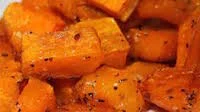Peg’s Blog
Food & lifestyle ideas to keep you healthy

What to Say to an Overweight Loved One: Help Them See Their Diamond Self
What to say and not say to an overweight loved one.


Roasted Butternut Squash with Turmeric and Curry
Always include squash on your Autumn Winter plate. It's easy to do with this simple recipe. Roasted squash makes a beautiful Thanksgiving dish.


The Blue Zones - I Just Knew It!
The Blue Zones are the areas of the world with the healthiest, longest lived people reside. Check out what they eat and you might want to do the same.

Is Your Body Screaming at You? Here's Why You Must Be Pro-Active
Love your job? It's a good thing, until it's the only thing.

Kaizen = Continuous Improvement
Things don't happen overnight. Kaizen is the way of continuous improvement.

Toasted Farro Salad
Farro is a dense grain that makes a great salad, warm or cold. Add vegetables and olive oil and you have a complete vegetarian meal.


Foods to Help You after Cancer
Along with the opening graphic, see how certain foods support recovery from cancer.


Why Is Food Such a Big Deal?
When weight or illness keeps you up at night, make it simple and start with 6 easy steps.

Breast Health Month
Why it makes sense to emphasize breast health, not breast cancer in th month of October

Apple Salad with Gorgonzola Cheese
Apple with gorgonzola and nut salad is the perfect touch for an Autumn meal
